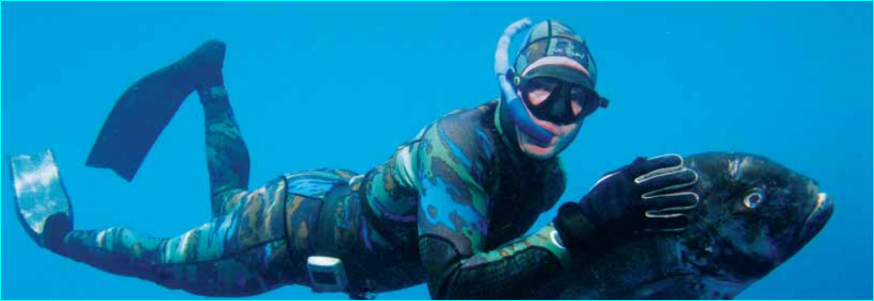
In Volume 5, we looked at the different types of neoprene fabrics and how they are applicable to various styles of wetsuits. Continuing on from this, we will now look at each of the stages of the manufacturing process of how a spearing wetsuit is made.
Like most items in the apparel trade, wetsuits are handmade. Each and every one, whether it is a specialised tailor fitted suit or a general off the rack size, is made individually, one at a time. There are no mechanised solutions or automated production facilities that are capable of mass-producing wetsuits and this makes the manufacturing process extremely labour intensive.
The first step is the layout of the pattern. The pattern cutter selects the correct sheet of neoprene fabric and lays out the pattern pieces so that they fit correctly on the sheet of neoprene fabric. This will ensure that maximum efficiency is maintained and that as little neoprene as possible is wasted. Once all the individual panel pieces of the wetsuit have been laid out, their shapes are traced onto the fabric with a chalk pencil. It is during this step that tailor-made suits are sized. The pattern cutter will adjust the size of each individual panel to ensure the optimal fit for the customer. The individual pieces are then carefully cut out, ensuring that their shapes are true to the original pattern. Once all the panel pieces have been cut, they are checked against the pattern again to ensure their orientation is correct. Loose edges are trimmed to ensure a smooth finish and all the panel pieces are checked once more for consistency.
The next step is the printing process of any logos or brand names. The pieces requiring printing are placed into a screen-printing machine and the required branding is applied using specialised plastic based inks. The inks used on wetsuits are highly elastic as they are required to bond with the fabric as it stretches without flaking or peeling. Each printed panel piece is then placed in an oven to cure the print. Once the printed panels are checked, they are then placed together with the remaining panels and are ready for assembly.
The manufacture of a spearfishing wetsuit follows a unique process called gluing and blindstitching. This ensures that all the seams are watertight and also allows minimal water flow through the suit. The gluing process begins with the edges of each panel piece of the wetsuit being coated with vulcanising cement. This is done by hand and each piece has to be coated individually. Once the cement has dried and cured, a second application is applied. As the second application begins to dry, the pieces are joined together in their appropriate sections in the same manner as a jigsaw puzzle. The fabric panels are joined edge to edge until the entire wetsuit has been completed.
Once the wetsuit has been completely glued together, the seams are left to cure for 24 hours. This allows maximum bonding for the cement and allows the chemical reaction of the gluing process to strengthen without undergoing any stress. A well-glued wetsuit will have flexible seams and often during stress tests, the neoprene fabric will tear before the glued seam fails.
Once the gluing process has been completed, the seams are checked for inconsistencies. The suit is then stretched to confirm the strength of the seams and ensures that the highest quality standards are maintained. The next step is to sew all the seams to further strengthen the integrity of the suit. A specialised stitching technique known as blindstitching is used. The process involves a unique sewing machine, which uses a needle that only penetrates the upper level of the fabric when sewing the panels together.
This method of stitching is essential in ensuring waterproof seams. One of the unique characteristics of the blindstitch process is that the entire wetsuit is sewn twice. The inside seams of the wetsuit are sewn first, and then the wetsuit is turned inside out and the seams are sewn again from the outside.
Once the wetsuit has been completely sewn, the seams are checked to ensure the stitching is secure, straight and correctly tensioned. A liquid seal is applied to the seams as this will further strengthen and waterproof them. The edges of the suit are Are then hemmed or sewn with an elasticised binding tape. This further strengthens the structure of the seams and also provides an aesthetic finish to the wetsuit. The next step is to apply any additional trimmings like loading pads or pockets. The wetsuit is finally cleaned and all loose threads are trimmed and excess glue removed.
And then, the wetsuit awaits its turn to become a part of someone’s ultimate adventure…
